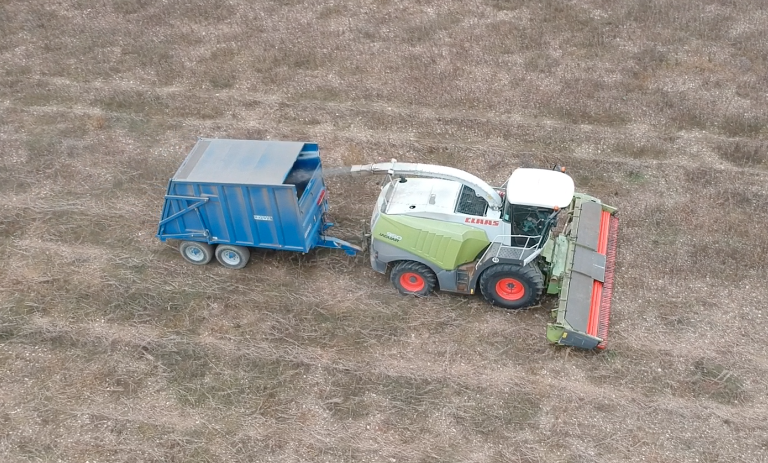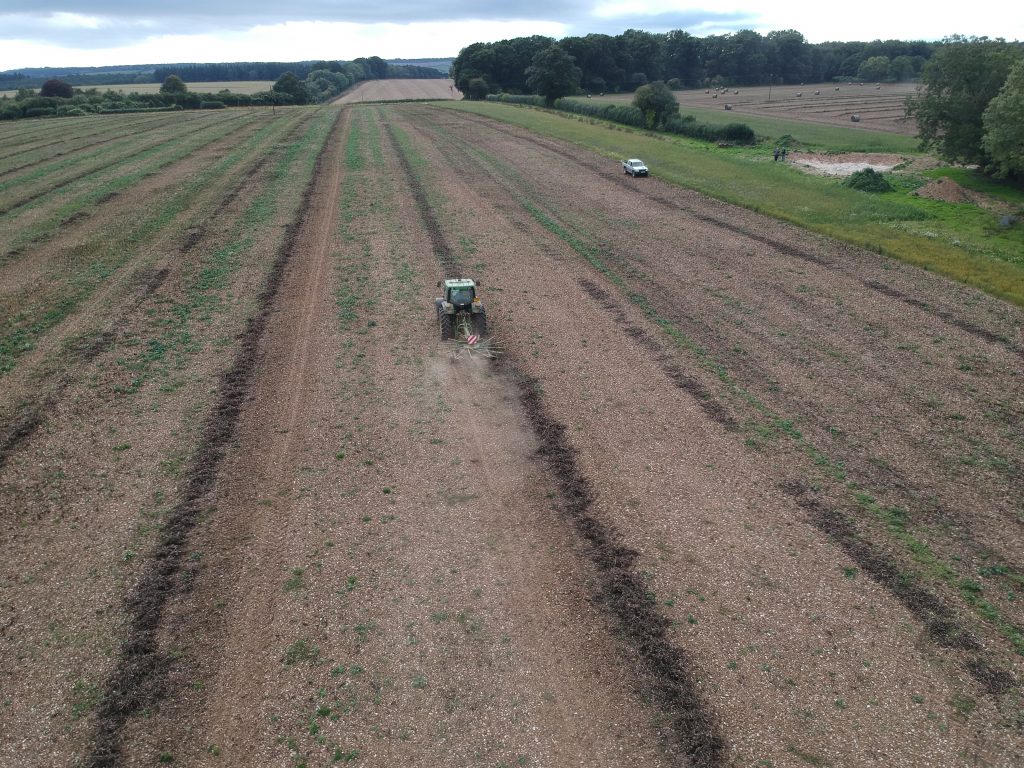View from the Hill 13th September 2020

The autumnal hue of the quinoa behind the sunflower sets off its bright yellow in the sinking evening sun. The quinoa (pronounced kwinower, not keenwah in this part of Dorset) ripens through a seemingly random variety of colours, and then offers a huge amount of food for the birds’ larder for the winter. Not be confused with fathen, or goosefoot, both annoying arable weeds which produce a similarly laden seed head, and which are impossible to control in a bird food plot containing quinoa, as they are too closely related to be able to use a weedkiller.
Harvest is very nearly complete, the poppy team arrived on Tuesday evening, a very short visit, they made quick work of knocking off the patches worth harvesting across 50 hectares of the scruffiest, most useless and embarrassing crop we have ever grown. A grand total of around 16 tons, where there should have been nearer 100, will not anywhere near cover its costs, and we cannot wait to finish tidying up the stems left by the harvester, with our combine, and getting Gary into the field with the discs, to consign the whole sorry mess to history. What went wrong? A too dry seedbed followed by a 2 month drought. This, for a small seeded crop, is fatal. Seriously delayed germination, followed by dry weather and more dry weather meant a very short growing season for what was already a very thin crop.

In the end, now the dust has settled, the 2020 harvest on this farm can be seen as a bit of a lucky escape. The season started most unpromisingly, with autumn planting delayed more than a month past normal sowing time, well into November. Torrential rain began on September 22nd, just as most arable farmers are about to sow their autumn crops, and it barely let up till the middle of March. Fortunately our chalk based soils gave us enough opportunity to get our winter crops sown by mid November, and then the beautiful bright sunny weather through April May and June was just what the plants needed to recover and grow well. For many soils though, the wet autumn was too much, lots of farmers were not able to plant any winter cereals at all, and even their spring cereals struggled with late sowing followed by prolonged periods of drought through the growing season. Rape crops struggled against the onslaught of the cabbage stem flea beetle, of which I have written too many times before. All in all, for many, 2020 is a farming year to be forgotten, (as for the rest of life under covid, I won’t go there) and now we look forward to starting again with a clean sheet for the 2021 season.

We sowed our oilseed rape crop in mid August, and so far it has all emerged and has only shown light beetle grazing. We do not intend to start sowing wheat until well into October, and hope we can complete by early November. It is a risky strategy, but so is sowing early, if you are determined not to use insecticide to control the aphids that carry barley yellow dwarf virus (BYDV, in spite of its name it can affect all cereal crops). As the weather cools into autumn, aphid flighting falls off and infection risk reduces. BYDV can decimate a crop in a bad year, but in many years, the aphid are not even carrying the virus, so why continue to risk harming potential aphid predators with insecticide every year? Sow later, plant flowers, wear sandals……

These turnips were sown, with minimal disturbance to the stubble, back in August after the wheat was cut and the straw cleared. They were sown with some phacelia and clover, to make the mix more interesting for the animals who graze it in winter, and to give the soil biology a bit of variety. The roots of the different species will encourage more activity amongst the fungi and bacteria who live in the soil, and develop useful relationships between soil and plants. The plant roots pump sugars into the soil to feed the fungi, which in turn scavenge the soil for nutrients for the plants. The sugars and fungi form glomalin, the healthy building block of fertile soils. It sticks soil particles together and helps to create a healthy structure, richer in organic matter, which is weather proof, more resistant to erosion, and better able to hold water and nutrients to support plant growth. This is part of the foundation of regenerative agriculture, which is a growing movement in various parts of the world, determined to reduce reliance on pesticides and artificial fertilisers.

A number of books have been published, including one called ‘Dirt to Soil’ by an American – Gabe Brown, on this subject. Always wary of anyone who preaches a bit loud, it is easy to be cynical, but there are many elements which make plenty of sense, and gave us the nerve to establish 40 acres of herbal ley last autumn. These 40 acres have continued to grow vigorously all summer, in spite of the lack of rain, and have fed our beef cows admirably, whereas the old permanent pastures simply gave up and turned brown. When we return these 40 acres to arable in two years’ time, we hope that the benefit of multi-species roots, animal grazing and their manure will give a shot in the arm to soils that have been arable cropping for more than 30 years.

Permanent wild flower strips established in rape field, a refuge for insects, and in particular the predators of crop pests.


Dougal scraping bean haulm into lines for Gary to bale, with our ‘new-to-us’ rake. We are short of fodder after the dry summer, so everything counts, and here we managed to find another 80 bales. The beans struggled to produce much yield, they prefer a wet summer, and they have not out-performed the rape in terms of overall return.



Lovely field mushrooms contribute to another wholly home grown meal thanks to 2020 lock-down projects including enlarged veg garden, the potato field, and the piggies (see recent episodes).


Gary’s tractor is treated to a new set of tyres, not for the financially faint-hearted. This is its third set since new, they last for around 2500 hours, which for this tractor is around 4 seasons.

Some of Robert Hogben’s bee hives, stacked high with honey supers after a wonderful long sunny flowery summer.

Phacelia flowers near the end of their season, almost unrolled, they unfurl and flower for weeks on end.
Little lambs in May grow into bigger lambs by September…..



Hi George
Many thanks for the very interesting heartfelt blog. I really sincerely hope that 2021 is a lot kinder to you. This year must be gut wrenching for you, all of the hard work and investment and no result.
But chin up, smile it will get better, I hope. We really enjoyed our time over with you. Are all the spuds gone? We are still eating them. They have a lovely flavour. I love foraging and when I saw those mushrooms, I was very jealous. I still dream of hunting for gold in Australia, one day. But mushrooming has always captivated me.
By the way Tom my son in law flys Hawks. Have you any spots that he could indulge himself? He is a fine lad, you would love him. He has just bought a 1957 Bedford lorry, he keeps this at Enford. I love riding in the noisy old thing.
Wow, best close. Many thanks George, you are a good man.
Best wishes
Bill
2021 Farming on WTO terms?
Thanks, George, all very interesting. Yes, I did wonder whether that abundant clovery stuff on which the cattle are grazing above Sutcombe Wood was herbal ley. Looks delicious. And I gather you have no reactors! Congratulations, Susan
Tomato seeds survive the alimentary systems of many animals particularly monogastrics like us.